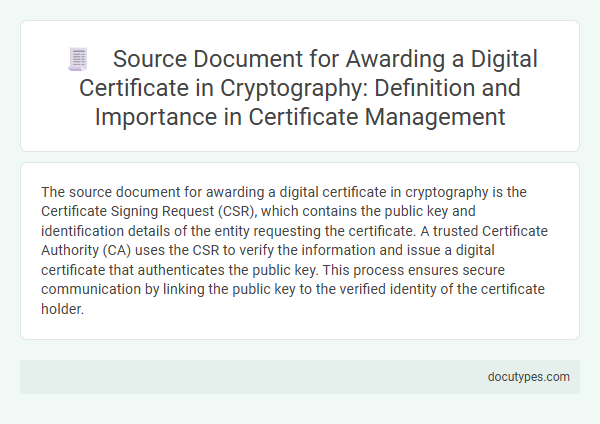The source document for awarding a digital certificate in cryptography is the Certificate Signing Request (CSR), which contains the public key and identification details of the entity requesting the certificate. A trusted Certificate Authority (CA) uses the CSR to verify the information and issue a digital certificate that authenticates the public key. This process ensures secure communication by linking the public key to the verified identity of the certificate holder.
Overview of Source Documents in Digital Certification
The source document for awarding a digital certificate in cryptography is typically a Certificate Signing Request (CSR). This document contains your public key and identifying information, which a Certificate Authority (CA) verifies before issuing the digital certificate. The CSR acts as the foundational proof that ties a public key to a specific entity in digital certification processes.
Defining the Source Document in Cryptographic Processes
The source document for awarding a digital certificate in cryptography is the original data or information used to generate the certificate's cryptographic attributes. This document serves as the foundation for verifying the identity and credentials of the certificate holder.
In cryptographic processes, defining the source document is critical to ensure the authenticity and integrity of the digital certificate. Your digital certificate relies on this verified source document for secure communication and trust in digital interactions.
Role of the Source Document in Awarding Digital Certificates
What is the source document for awarding a digital certificate in cryptography? The source document is typically a Certificate Signing Request (CSR) submitted by the entity requesting the certificate. This CSR contains crucial information such as the public key and identification details needed to verify the requester's identity before the certificate is issued.
What role does the source document play in awarding digital certificates? The source document serves as the foundational proof of identity and technical data that Certificate Authorities (CAs) use to validate and authorize the issuance of digital certificates. It ensures the authenticity and integrity of the certificate, enabling secure communications and trust in digital environments.
Key Elements Contained in Source Documents
| Source Document for Awarding a Digital Certificate | The source document is typically a Certificate Signing Request (CSR), which initiates the issuance of a digital certificate by a Certificate Authority (CA). |
|---|---|
| Key Elements Contained in Source Documents |
|
| Purpose of Source Document Elements | These elements enable the CA to verify identity, validate cryptographic keys, and establish trust in the digital certificate before awarding it. |
Importance of Source Documents in Certificate Lifecycle Management
The source document for awarding a digital certificate in cryptography is the validated proof of identity or authorization submitted during the registration process. This document ensures the authenticity and trustworthiness of the entity receiving the certificate.
- Verification Accuracy - Source documents ensure that your identity is accurately verified before certificate issuance.
- Trust Establishment - They form the foundation of trust between certificate authorities and certificate holders.
- Lifecycle Management - Source documents support ongoing certificate lifecycle processes including renewal and revocation.
Proper management of source documents is crucial to maintain the integrity and security of digital certificates throughout their lifecycle.
How Source Documents Ensure Certificate Authenticity
The source document for awarding a digital certificate in cryptography is the Certificate Signing Request (CSR) submitted by the entity requesting the certificate. This document contains crucial information used to verify the identity before certificate issuance.
Source documents ensure certificate authenticity by providing validated data to the Certificate Authority (CA), which confirms the legitimacy of the request. Your trust in digital certificates depends on the integrity of these source documents.
- Identification Verification - The source document includes verified identity details essential for authenticating the certificate holder.
- Data Integrity - The CSR contains cryptographic keys and information that must remain unaltered to maintain certificate validity.
- Audit Trail - The source document serves as evidence in the certification process, supporting trust and traceability.
Source Document Verification Procedures
The source document for awarding a digital certificate in cryptography is typically a government-issued identification or an official business registration document. Source document verification procedures involve validating the authenticity and accuracy of these documents through trusted databases or third-party verification services. This process ensures that the digital certificate is issued to the rightful entity, maintaining the integrity and trustworthiness of the cryptographic system.
Impact of Source Document Integrity on Trust and Security
The source document for awarding a digital certificate in cryptography is typically a Certificate Signing Request (CSR) submitted by the entity requesting the certificate. This document contains critical information such as the public key and identification details necessary for certificate issuance.
Integrity of the source document directly impacts the trustworthiness of the digital certificate and the security of encrypted communications. If the CSR is tampered with or falsified, the resulting digital certificate may be compromised, leading to potential unauthorized access or data breaches. Ensuring the authenticity and accuracy of the source document is essential for maintaining confidence in cryptographic systems and secure transactions.
Challenges in Source Document Management for Digital Certificates
The source document for awarding a digital certificate in cryptography is typically the Certificate Signing Request (CSR) submitted by the entity seeking certification. This document contains the public key and identifying information that must be verified before the certificate authority (CA) issues the digital certificate.
Challenges in source document management for digital certificates include ensuring the authenticity and integrity of the CSR throughout the validation process. Secure storage and controlled access are critical to prevent tampering or unauthorized use, which could compromise the trustworthiness of the issued certificate.
What Is the Source Document for Awarding a Digital Certificate in Cryptography? Infographic

